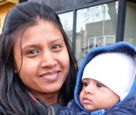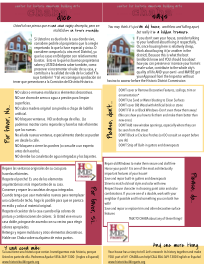North Pearl Street, looking South
OUR MESSAGE TO THE COMMUNITY..
...that the Historic District is more than a record of the past. It is a way into a livable future and a better quality of life.. It is a leg-up on the American Dream. It is a technology for affirming the value of homeownership and home care, and an accessible, affordable way to raise the value of that home through self-help and skills-building.


![[chaba]](HomeFronts_files/shapeimage_3.png)






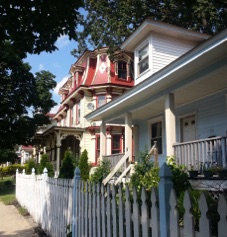

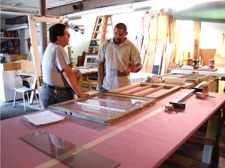




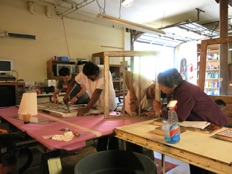


“LAS GUIAS”
[the District Guidelines in Spanish]
Though technically under copyright, the “Guias” (translated from Bridgeton’s original 1990 Design Guidelines) are accessible here in their entirety. We think the original Guidelines themselves need serious updating, but as long as they are still in use by the Historic District Commission, everyone who lives or owns property in the District should know what they say.
This AWARD-WINNING translation and their recasting as “PowerPoint Videos” was partially funded by the City of Bridgeton CDBG program, the Cumberland County Cultural & Heritage Commission, and State Farm Insurance.
Thank you!


A gateway “HomeFront”
on N. Pearl Street
Launching “Las Guias”: September 2013. Professor Robyn Rodriguez, Hector Brambila; Inset (LtoR): Jaime Bustos-DeHaro, Brambila, historic architect Maria Cerda-Moreno


HomeFronts credo:
Preservation without gentrification:
Continuity in the story of the district is part of what we are preserving. Homes that served working class immigrant cultures in the past can do it again. The inherent beauty and craftsmanship in these homes is one of the defining characteristics of the Bridgeton Historic District. It is not just a physical but a cultural and ethical characteristic.
Preservation = sustainable development:
We will not dump some of our most colorful, interesting and significant stories into landfills. We will learn to make the places that tell these stories be the most planet-friendly and non-toxic environments they can be.
Preservation = skills-building
No one ever regretted learning how to make something beautiful, or how to make something beautiful last a little longer.
GETTING STARTED
A generation had passed. People needed to be reminded what the District was about, and why it might still be good--even if under different socioeconomic conditions from those that had created it.
Newcomers, too, confronting a “certificate of appropriateness” for the first time, often needed to get past a simple language barrier to know what obligations and conditions might come with buying and altering structures.
So beginning in 2012-13, with the assistance of several local funders, CHABA launched its “Historic Home Stewardship initiative,” a catchall educational project that would include
(1) a translation of the longstanding City of Bridgeton Design Guidelines into Spanish;
-
(2)the design and initiation of introductory educational meetups;
-
(3)The creation of VIDEO versions of the Guidelines in English and Spanish for an immediate, accessible introduction to the district and tools for maintaining it;
-
(4)hands-on repair/restoration workshops in various aspects of historic fabric management and repair.
THE TRANSLATION OF THE GUIDELINES
...was managed and supervised by Boardmember/architect Maria Cerda-Moreno. Working with student intern Jaime Bustos DeHaro, a Mexican-born Bridgetonian training in architecture at Boston Architectural College, enabled her and CHABA to underscore the learning value of this work, while Jaime helped assure linguistic accessibility to the local community.
Translating the GUIDELINES had seemed so obvious a way to begin to assure public access to information that when we were done, we were surprised to learn it was the first ever in the state.
We raised a toast in September 2013. Then we took our “Guias” on the road.
OTHER TEACHING TOOLS
Assisted by Hector Brambila, a graduate architect-engineer also from Bridgeton, Cerda-Moreno created a PowerPoint presentation in both English and Spanish on the intent of the Guidelines.
A raw from of this presentation is now available, and has assured that our workshops are accessible and provide clear visual interpretation of the Guidelines text.
HOMEFRONTS WORKSHOPS
Our HomeFronts workshops are the key medium of our message.
These simple meetups are advertised through churches and community organizations, by word of mouth and on the street. They vary from one hour to three depending on content, from introductory show and tell, to hands-on practicums.
They are designed for everyone: homeowners, renters, absentee landlords--men and women--beginners and pros--English and Spanish-speakers.
They give people access to what they need...or we hope they do. They are a beginning. We too learn--by getting feedback, asking what else WE need to know.
A window workshop
WE BELIEVE IN WHAT WE DO:
HomeFronts are opportunities to teach values as well as skills.
We like to think we are socially and ethically motivated in believing that access to some of the benefits of a shared quality of life in historic neighborhoods represents a real form of environmental and intergenerational justice.
But we are also building skillsets and, we hope, creating jobs and bettering daily living conditions. We think potential upward mobility through accessible property ownership is not pie in the sky. It is what Preservation Activism offers in the Bridgeton context.
And elsewhere?
Above: two sequential windows workshops in May 2014; below, Simplified Do’s/Don’ts...English & Spanish
About Us/Contact
Historic architect Maria Cerda-Moreno leads a recent introductory workshop in the basement meeting room of Immaculate Conception Church

HomeFronts brochure:
English ...and Spanish
“Most communities tend to focus on the preservation of their own cultures first, and an established community may view newcomers who bring different cultural traditions and values as disrupting what seemed a cohesive and even sustainable local cultural paradigm.
“Yet this is an illusion. The world is in motion; change impacts us in here as well as out there, and before we can begin to talk about ‘cultural sustainability’ as an organic and collective global practice, we must first understand it as dynamic, and work to promote, communicate and practice this dynamic adaptation at the local level.
“But it can take just as much thoughtful and strategic planning to communicate and share ideas about a sustainable LOCAL cultural model as a global one. And it can be hard work to promote a sense of place and identity for everyone in a community--a sense of place that is both consistently flexible and welcoming, yet that thoughtfully--respectfully--adapts itself to the character of existing local cultures.
“But it is a goal worth striving for--if only because of the well-being that follows from communities and individuals--together--creating and enjoying social activities that promote and build a common cultural capital.
Above all, we should be wary of aiming for a cultural sustainability that too heavily relies on tangibles over intangibles. Cultural capital does not merely inhere in things--objects--buildings--what we see and feel. Cultural sustainability arises from a holistic sense of place and identity, where intellectual and spiritual experiences and values are as important to a whole sense of well-being as heritage buildings and art.
Freely adapted from Denise Scammon: "Sustainability and Culture--How Do They Work Together?" (2012)
...Building a Common “Cultural Capital” at the Local Level:

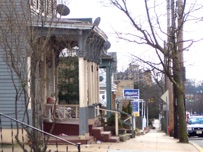
VIDEO



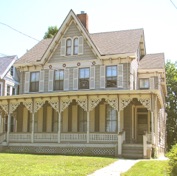
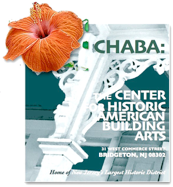
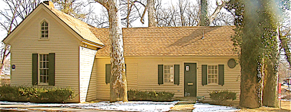




[chaba]
the Center for Historic American Building Arts
ReVisioning New Jersey's Largest Historic District
31 West Commerce Street
Bridgeton, NJ 08302
English: 856-221-3276
Español: 856-221-3239
cell: 201-321-3813





